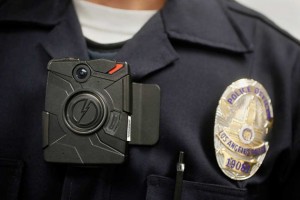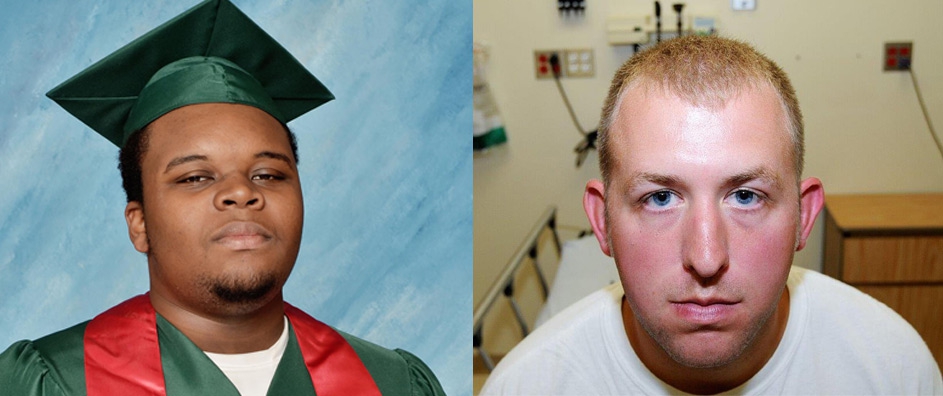The views expressed in our content reflect individual perspectives and do not represent the authoritative views of the Baha'i Faith.
“I felt like a 5-year-old holding onto Hulk Hogan.”
This descriptive passage comes from Officer Darren Wilson’s account of his shooting of 18-year-old Michael Brown. It puts a sharp mental image into the mind of the listener: a small child trying to restrain a massive celebrity wrestler. It tells us nothing about Michael Brown, but only conveys what Darren Wilson felt about himself in comparison.
Ex-officer Wilson’s subjective description, like everything subjective, is “based on or influenced by personal feelings, tastes, or opinions.” Some synonyms include: personal, individual, emotional, instinctive, intuitive.
Subjective descriptions do not convey knowledge about reality. So let’s look at the truth, the reality, what we can actually know about what happened when a white police officer shot an unarmed 18-year-old African American teenager and sparked a huge outcry over race and injustice.
In reality, Mike Brown and Darren Wilson both stood about the same height—6 foot, 4 inches. An 82 pound weight difference separated the two men (Wilson’s 210 to Mike Brown’s 292). One man was an armed, trained law enforcement professional; the other was unarmed and much younger—a teenager who just graduated from high school.
These important facts convey objective knowledge about reality–even though they’re not nearly as dramatic and emotionally engaging as that image of a five-year-old confronting Hulk Hogan. They fail to stick in the mind the way that simple picture does of a small, defenseless child trying to control a powerful foe.
In further testimony, Officer Wilson commented that: “At this point it looked like he was almost bulking up to run through the shots, like it was making him mad that I’m shooting at him. And the face that he had was looking straight through me, like I wasn’t even there, I wasn’t even anything in his way.”
Again, this is subjective, not factual. “It looked like” Brown meant to run through the shots. “It looked like” being shot at was making Brown mad rather than scared. Wilson had the impression that Brown was “looking straight through” him. These subjective descriptions tell us nothing about what Mike Brown actually did—something that witnesses do not agree on.
Finally, Officer Wilson offers a vivid description of Michael Brown as something less–or maybe more–than human. He remarks on the “intense aggressive” face Brown made at him. He tells the Assistant District Attorney, “The only way I can describe it, it looks like a demon, that’s how angry he looked.” Later, in response to a question, he would say, “I just felt the immense power that he had.”

Was Michael Brown “a demon” in possession of “immense power”? Of course not, and the fact that Darren Wilson’s bullets killed him proves it. But the impression hangs in the air like a hologram overlaying and blurring the reality—in truth, Michael Brown was a large young man whose battle prowess didn’t even run to martial arts training and who, at the point Wilson fired the lethal shot, was falling to the ground from loss of blood.
In the writing workshops I teach, I often advise aspiring writers not to pen descriptions like this for the simple reason that no one knows what a demon looks like or what a demonic expression entails. Writers use these kinds of subjective descriptions not to convey facts about the characters or to allow the reader to visualize settings and events, but to evoke emotions; to overlay or coat reality with emotion. The emotional component doesn’t tell the reader what actually happened, but only how the writer feels about it. Moreover, it tells the reader how to feel about it.
Demons are creatures of our imaginations; personifications of our fears. This evocative word calls upon a deep-seated primal terror of beings so powerful they cannot be stopped by mere mortals—not even with bullets. The problem? That word doesn’t tell us about the actual expression on Mike Brown’s face–it only tells us how Darren Wilson responded emotionally to seeing it.
What would a factual description of Michael Brown look like? It would answer questions like these: Were his brows furrowed? Had he bared his teeth? Were his eyes wide or narrowed? Were his arms close to his body or held out or up in front of him? Was he sweating? Crying? Swearing? Only Michael Brown ultimately knew whether his grimace was one of rage, as Wilson suggests, or whether it was a grimace of fear and pain, or a grimace of blind, reactive panic. How can anyone tell the difference from 100 feet?
We hear Officer Wilson’s words and form impressions of Mike Brown based on how they make us feel. I think most of us have had a friend or acquaintance tell us they interpreted our facial expressions or body language in ways that surprised us. In college a close friend told me that when she first met me she thought I was aloof and snobby, until she got to know me and realized I was merely painfully shy.
When these terrible incidents occur, we naturally want to know the truth. We want to see the objective reality, not someone’s subjective impressions. We hunger for what’s real, for the facts:
Never can reality and the mere semblance of reality be one, and wide is the difference between fancy and fact, between truth and the phantom thereof. – Abdu’l-Baha, Selections from the Writings of Abdu’l-Baha, p. 177.
Please follow along with this short series of essays, as we try to look beyond the fancy and the phantoms surrounding Michael Brown’s tragic death.
You May Also Like
Comments

















It's an odd thing, but most writers I know even dissect the horrific things that happen to them personally—accidents, visits to the emergency room, even the loss of a loved one. To paraphrase something I heard someone say of acting, writers are explorers of other people's souls.
And yes, the jury IS responsible for extracting the factual information from all of the hyperbole and emotionally charged descriptions. And because we are very susceptible to emotions, that can be difficult. Ultimately, they ask themselves, "If I felt like that, what would I do?"
I find it interesting that you believe I told people what to think. I didn't. I did suggest that the factors that made Darren Wilson so afraid of a young, unarmed black man were not based in fact, but rather in assumptions that we, as a people—as a species, need to challenge. If we can challenge those assumptions and rid ourselves of our ingrained prejudices, then we all stand a much better chance of seeing reality and making better choices.
Ironically, in several of the cases lately of young black men being killed or injured by police officers, we have video of the event. We can see the facts of the situation. Yet it still devolves on highly subjective input. The question is not what happened, but what did the officer believe had happened. I am not sure that question leads, in the end, to justice.
The author posed the question, "What would a factual description of Michael Brown look like?" Had the article included the full quote from Officer Wilson's grand jury testimony, it would be quite apparent that the officer had provided exactly the factual description which the artticle fails to recognize.
Officer Wilson's full and unabridged statement to the grand jury was...“And then after he did that, he looked up ...at me and had the most intense aggressive face. The only way I can describe it, it looks like a demon, that’s how angry he looked.”
The complete statement makes it abundantly clear that Officer Wilson was stating that Brown's expression was one of intense anger.
Furthermore, the author strayed dangerously far from a factual retelling of the events by the inclusion of a rhetorical question which suggests Officer Wilson was viewing Brown's expression from a distance of 100 feet.
In actuality, Officer Wilson was describing the face of an assailant who had shoved the officer back into his vehicle, slammed the door on him, struck him at least once in the face, and was engaged in a struggle for control of the officer's weapon. These are hardly events which can transpire at a distance off 100 feet as the author suggests, but actually occurred while the two were face to face and within arms reach of one another.
It is also misleading to refer to Brown as being unarmed. Based upon what is known about Brown's physical assault of a store clerk during his involvement in a strong armed robbery at the Ferguson Market, as well as what is known by both witness testimony and forensic evidence at the scene of the shooting, Brown quite clearly used his size and weight as his weapon.
I has hoped that a discussion of an inflammatory event such as the tragedy in Ferguson would be approached with a sincere dedication to approaching that discussion with a concern for truth and the facts of the event. This article demonstrates neither.
I've had the experience of having someone tell me, "I didn't like SoandSo. They seemed arrogant." When I ask why they say that, I often get "They had an arrogant expression on their face." But what seemed an arrogant expression to them looked like a concerned expression or an interested expression to me. Often the difference was one of familiarity. I knew the person somewhat, the individual commenting on their arrogance had just met them.
I never doubted that Officer Wilson was frightened or at least greatly concerned. My point was that his reasons for having such a strong reaction had less to do with reality than his perception of it.
Also, I was not referring to their encounter at the police car, but rather the situation Wilson was describing at that time: Brown had run away from his vehicle to a distance ...that I have repeatedly seen given as over 100 feet. In the panic of the moment, given that Brown was at this point moving back toward Wilson, it would be highly improbable that Wilson's sense of the situation and his reading of Brown's face were not filtered through fear and other highly charged emotions
My point was that the most damning testimony given by Wilson—the testimony that cast Mike Brown as a superhuman demon in a rage so complete he was impervious to bullets—was not "factual". It was subjective and emotionally charged. The only person who knows what Michael Brown's intentions were in the moments before his death is Michael Brown and he is not here to tell us.
Justice is indeed the necessary virtue here, because it is too easy to be swayed by emotion and to make decisions—as ...consumers of information or as a member of a jury—based on empathy with the person telling the most vivid and emotionally evocative story.